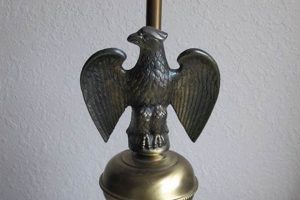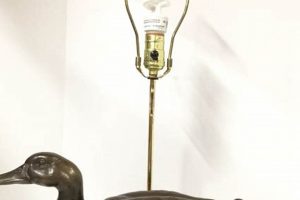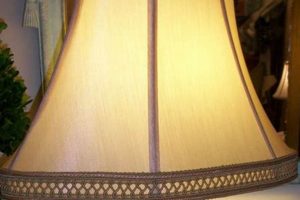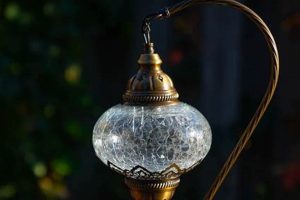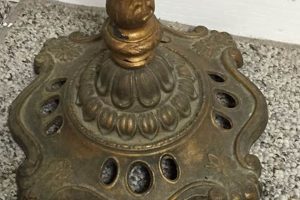A specific type of decorative lighting fixture, popular in the mid-20th century, utilized a pump to circulate oil through strands of filaments. This created the illusion of falling rain, with the oil often scented for an added sensory experience. These fixtures were typically adorned with figurines or other embellishments, contributing to their aesthetic appeal. Their construction commonly involved a combination of metal, plastic, and glass components.
The appeal of these lighting pieces lay in their novelty and visual dynamism, offering a unique focal point for interior spaces. Their popularity coincided with an era characterized by a fascination with simulated natural effects and technological advancements in household dcor. These devices represent a particular design aesthetic and technological approach to domestic illumination from a bygone era, offering a glimpse into the stylistic preferences and technological capabilities of the time. Their value today rests in their collectibility and the nostalgic appeal they hold for many.
The subsequent sections will delve into the components, maintenance considerations, common issues encountered, and the process of assessing the value of these distinctive pieces of lighting history.
Tips for Owning and Maintaining a Vintage Oil Rain Lamp
The following guidelines offer practical advice for prospective owners and current custodians of these vintage fixtures, ensuring longevity and optimal functionality.
Tip 1: Proper Oil Selection: Utilize only oil specifically formulated for these lamps. Standard mineral oil may be too viscous, potentially causing pump malfunction or filament clogging. Look for products labeled as “rain lamp oil” or equivalents.
Tip 2: Regular Cleaning Regimen: Periodically disassemble and clean the individual strands and the reservoir. Dust accumulation can impede oil flow and diminish the visual effect. Use a mild detergent and warm water for cleaning, ensuring all components are thoroughly dried before reassembly.
Tip 3: Pump Inspection and Maintenance: The pump is a crucial component. Examine it regularly for signs of wear or debris accumulation. Consider disassembling and cleaning the pump periodically, following the manufacturer’s instructions if available, or consulting with a qualified repair technician.
Tip 4: Avoid Overfilling the Reservoir: Overfilling can lead to leaks and potential damage to surrounding surfaces. Adhere to the fill level indicated in the lamp’s documentation or, if unavailable, maintain a level below the pump intake to prevent overflow.
Tip 5: Safe Placement and Operation: Position the lamp on a stable, level surface, away from flammable materials. Ensure adequate ventilation to prevent overheating of the pump. Never leave the lamp unattended while operating.
Tip 6: Replacement Parts Sourcing: Finding replacement parts can be challenging. Explore online marketplaces specializing in vintage lighting components, or consult with lighting repair specialists who may have access to salvaged parts or be able to fabricate custom replacements.
Tip 7: Wiring and Electrical Safety: Before operation, inspect the wiring for damage or deterioration. If any issues are detected, consult with a qualified electrician to ensure safe operation and prevent electrical hazards. Consider replacing old wiring with modern alternatives for enhanced safety.
Adhering to these recommendations will contribute to the preservation and enjoyment of these unique and historically significant lighting artifacts.
The subsequent section will address troubleshooting common malfunctions and assessing value.
1. Aesthetic Design
The aesthetic design of vintage oil rain lamps represents a confluence of mid-century stylistic trends and technological capabilities. These fixtures served not merely as sources of illumination, but as decorative objects that reflected the design sensibilities of their era.
- Figurines and Sculptural Elements
Many pieces feature integrated figurines or other sculptural elements, often rendered in materials such as plastic or metal. These figures, ranging from classical motifs to representations of nature, contribute significantly to the overall aesthetic. The choice of subject matter and style reflects the artistic trends prevalent during the lamp’s production, providing insight into the cultural tastes of the period.
- Material Palette and Finish
The materials employed in construction, including metals, plastics, and glass, contribute to the lamp’s visual character. The finish applied to these materials, whether polished, brushed, or patinated, influences the overall impression. Common finishes include gold-tone, brass-tone, and various colored plastics, each contributing to a distinct aesthetic.
- Form and Proportion
The overall form and proportion of these fixtures impact their visual appeal. Some lamps feature vertical, chandelier-like designs, while others adopt more horizontal or geometric configurations. The interplay between the lamp’s structure and the falling oil creates a dynamic visual element that defines its aesthetic.
- Illumination and Light Quality
Beyond their sculptural qualities, these lamps provide illumination. The quality and intensity of the light, often diffused by the falling oil, contribute to the ambiance. The specific color temperature and brightness influence the overall aesthetic, creating a unique and inviting atmosphere. Some models incorporate colored bulbs or filters to further enhance the light’s aesthetic properties.
These design aspects, taken together, determine the unique aesthetic identity of each vintage oil rain lamp. Their appeal lies not only in their function as lighting sources but also in their embodiment of a particular design era, rendering them sought-after collectibles and evocative artifacts of the mid-20th century.
2. Mechanical Function
The mechanical function is central to the operation and aesthetic effect of this decorative lighting. Without a properly functioning mechanical system, the fixture ceases to perform its intended purpose. The core component is typically a small electric pump, responsible for drawing oil from a reservoir and propelling it upwards to a distribution system located at the top of the lamp. This distribution system then disperses the oil, allowing it to cascade down along strands of monofilament or fine wire, creating the illusion of falling rain. The pump’s performance, therefore, directly dictates the volume and consistency of the oil flow, thus influencing the visual impact of the lamp. A worn or malfunctioning pump results in diminished or inconsistent oil flow, detracting significantly from the intended aesthetic effect.
Real-world examples underscore the importance of proper mechanical function. A pump that is partially clogged or operating at reduced capacity may produce only a trickle of oil, rather than the desired cascading effect. Similarly, a pump with a worn impeller or damaged housing may generate excessive noise or fail to maintain sufficient pressure, leading to uneven distribution of oil across the strands. Addressing these mechanical issues often requires disassembly, cleaning, and, in some cases, replacement of the pump. Neglecting these mechanical aspects not only compromises the lamp’s visual appeal but can also lead to premature failure of other components due to increased strain on the system.
In summary, the mechanical function is paramount to the operability and aesthetic appeal of these vintage lighting fixtures. A properly functioning pump and distribution system are essential for creating the desired illusion of falling rain. Regular maintenance and timely repairs are crucial for preserving the mechanical integrity of these lamps, ensuring their longevity and continued enjoyment as decorative objects. Understanding the underlying mechanical principles and potential points of failure is vital for both owners and restorers of these vintage artifacts.
3. Original Components
The presence and condition of original components significantly influence the value, authenticity, and operational viability of any vintage oil rain lamp. The extent to which a lamp retains its factory-installed parts serves as a key indicator of its preservation and a determinant of its historical significance.
- Pump Assembly
The original pump is a critical indicator of a lamp’s authenticity. Original pumps often feature specific markings, materials, or construction techniques unique to the manufacturer or period of production. Replacement pumps, even those designed for similar applications, may alter the lamp’s oil flow rate, noise level, or overall reliability. Identifying and preserving the original pump is crucial for maintaining the lamp’s intended functionality and historical accuracy.
- Plastic Strands
The plastic strands or filaments that create the “rain” effect are frequently subject to degradation over time, becoming brittle, discolored, or broken. Original strands, if intact, provide valuable information about the lamp’s original design and aesthetic intent. Replacement strands, while necessary for restoring functionality, may differ in material composition, thickness, or length, affecting the lamp’s visual appearance. Documenting and, if possible, preserving the original strands is important for maintaining the lamp’s historical integrity.
- Electrical Wiring and Components
The lamp’s original wiring, switch, and plug are often subject to deterioration or replacement due to safety concerns or wear. While upgrading these components may be necessary for safe operation, the original wiring and electrical parts can provide clues about the lamp’s age, manufacturing standards, and intended usage. Retaining these original components, even if non-functional, can be valuable for research and documentation purposes.
- Reservoir and Housing
The oil reservoir and surrounding housing, typically constructed of metal, plastic, or glass, are integral to the lamp’s structural integrity and aesthetic appeal. Original reservoirs and housings exhibit the design and manufacturing characteristics of the period, reflecting the materials and construction techniques prevalent at the time. Damage or replacement of these components can detract from the lamp’s value and authenticity. Preserving the original reservoir and housing is essential for maintaining the lamp’s structural and historical integrity.
The degree to which a vintage oil rain lamp retains its original components directly correlates with its value, authenticity, and historical significance. While restoration efforts may necessitate the replacement of certain parts to ensure safe and reliable operation, the preservation and documentation of original components is crucial for maintaining the lamp’s integrity as a cultural artifact. Collectors and restorers should prioritize the identification, preservation, and documentation of original components to enhance the lamp’s value and historical relevance.
4. Electrical Safety
The electrical safety of vintage oil rain lamps constitutes a critical consideration for owners and enthusiasts. These fixtures, often decades old, frequently predate modern safety standards and may exhibit compromised wiring or components. A thorough assessment of the electrical system is essential prior to operation to mitigate potential hazards.
- Wiring Insulation Degradation
Over time, the insulation surrounding electrical wiring can become brittle, cracked, or frayed due to age, heat exposure, and environmental factors. This degradation exposes conductors, increasing the risk of short circuits, electrical shocks, and fire hazards. A visual inspection of the wiring for signs of damage is imperative. Replacement of deteriorated wiring with modern, appropriately rated wiring is a recommended safety precaution.
- Grounding and Bonding
Many older electrical systems lack proper grounding, which provides a low-resistance path for fault currents to return to the source, tripping circuit breakers or fuses. The absence of grounding increases the risk of electrical shock if a fault occurs. Retrofitting a ground wire to the lamp’s chassis and ensuring proper bonding of metal components are essential safety measures.
- Switch and Socket Integrity
Vintage switches and sockets may exhibit wear, corrosion, or damage, leading to intermittent operation, overheating, or electrical arcing. These issues can pose a fire hazard and compromise the lamp’s reliability. Replacement of faulty switches and sockets with modern, UL-listed components is advisable.
- Overcurrent Protection
Older electrical systems may lack adequate overcurrent protection, such as circuit breakers or fuses, to interrupt fault currents and prevent damage to the wiring and connected equipment. Installing a properly sized fuse or circuit breaker in the lamp’s power cord or circuit is a crucial safety measure to protect against overloads and short circuits.
Addressing these electrical safety concerns is paramount before operating vintage oil rain lamps. Neglecting these issues can result in serious injury, property damage, or fire. A qualified electrician should be consulted to perform a thorough inspection and implement necessary upgrades to ensure the safe and reliable operation of these vintage fixtures. Prioritizing electrical safety safeguards the enjoyment and preservation of these artifacts for years to come.
5. Oil viscosity
The operational effectiveness of a vintage oil rain lamp is inextricably linked to the oil’s viscosity. This property, defining a fluid’s resistance to flow, directly impacts the lamp’s aesthetic performance. If the oil is too viscous, the pump may struggle to circulate it adequately, resulting in a weak or nonexistent “rain” effect. Conversely, if the oil is too thin, it may flow too rapidly, compromising the desired visual spectacle and potentially leading to leaks. Therefore, selecting an oil with the appropriate viscosity is paramount for optimal functionality.
The original manufacturers of these lamps typically specified an oil viscosity range suitable for their designs. Using an oil outside of this range can have detrimental effects. For example, employing a heavy machine oil in place of a lighter mineral oil can overload the pump, potentially causing it to fail prematurely. Similarly, utilizing a volatile solvent might create the “rain” effect, but its rapid evaporation poses a fire hazard and could damage the lamp’s plastic components. The ideal viscosity ensures a consistent, visually appealing flow rate while minimizing stress on the pump and other parts. Understanding the relationship between viscosity and lamp performance enables informed oil selection.
In conclusion, oil viscosity is a critical determinant of a vintage oil rain lamp’s functionality and longevity. Selecting an oil within the manufacturer’s recommended range, or opting for a commercially available “rain lamp oil,” helps guarantee a balanced and visually pleasing performance while preserving the lamp’s mechanical integrity. Careful consideration of oil viscosity is essential for maintaining the aesthetic appeal and operational health of these vintage lighting fixtures.
6. Filament Integrity
The condition of the filaments within a decorative lighting fixture directly influences its operational function and aesthetic presentation. These components serve as the conduits along which the circulating oil flows, creating the signature “rain” effect. Their structural integrity is paramount for optimal visual performance and longevity of the fixture.
- Material Degradation
Filaments, often constructed from fine plastic strands or thin wires, are susceptible to degradation over time. Exposure to oil, dust, and ultraviolet light can cause the material to become brittle, discolored, or weakened. Compromised filaments may break, sag, or develop surface imperfections, disrupting the uniformity and visual appeal of the oil flow. Regular inspection for signs of material degradation is essential for maintaining the lamp’s aesthetic quality.
- Surface Contamination
The accumulation of dust, debris, or oil residue on the filament surfaces can impede the oil’s flow, causing it to drip unevenly or to cease flowing altogether in affected areas. This contamination diminishes the desired rain effect and can necessitate cleaning or replacement of the filaments. Periodic cleaning with a mild detergent and soft cloth helps to remove surface contaminants and maintain optimal oil flow.
- Alignment and Tension
Proper alignment and tension of the filaments are crucial for ensuring a uniform and visually appealing rain effect. Misaligned or sagging filaments can disrupt the flow pattern, creating an uneven or asymmetrical appearance. Adjusting the filament alignment and tension may require disassembly and reassembly of the fixture. Care should be taken to avoid over-tightening or damaging the filaments during adjustment.
Maintaining the integrity of the filaments is vital for preserving the aesthetic qualities and operational functionality. Regular inspection, cleaning, and careful handling are essential practices for owners seeking to maximize the lifespan and visual impact of these unique lighting artifacts.
7. Historical Provenance
The historical provenance of a vintage oil rain lamp profoundly influences its value and collectibility. Establishing a clear and verifiable historytracing its origins, manufacturing date, and any significant ownershipsubstantially enhances its appeal to collectors. Provenance provides context, transforming a mere decorative object into a tangible link to a specific era. For instance, a lamp demonstrably manufactured by a renowned company during the peak of the style’s popularity commands a higher premium compared to an indistinguishable piece with unknown origins. Scarcity, too, is interwoven with provenance; a documented production limited to a specific year or a connection to a notable historical event elevates its status. Documentation such as original receipts, manufacturer’s catalogs, or testimonials from previous owners serve as critical supporting evidence, substantiating claims of historical significance.
The absence of a verifiable history often relegates a vintage oil rain lamp to a lower tier in terms of valuation. While aesthetic appeal and functional condition remain essential, they cannot compensate for the lack of documented origins. The market for such items operates on trust, and verifiable provenance engenders confidence among buyers. In practical terms, a lamp with a well-documented history can be sold at auction with greater certainty of achieving a high price, or be more readily accepted into a museum or private collection. Conversely, a lamp lacking provenance might face skepticism, hindering its salability and potentially diminishing its perceived value. Restorers and conservators often rely on historical records to accurately guide their work, ensuring the preservation of the lamp’s original characteristics and preventing unintended alterations that could compromise its historical integrity.
In conclusion, historical provenance represents a cornerstone in the assessment and appreciation of vintage oil rain lamps. It not only authenticates the object’s origins but also imbues it with cultural and historical meaning, significantly impacting its market value and scholarly significance. The diligent pursuit and preservation of such historical documentation are thus crucial for collectors, dealers, and researchers seeking to understand and celebrate these artifacts of mid-century design. The challenge lies in the often fragmented and incomplete nature of historical records, underscoring the need for meticulous research and careful interpretation when evaluating the provenance of a vintage oil rain lamp.
Frequently Asked Questions
This section addresses common inquiries regarding vintage oil rain lamps, providing factual information to assist collectors and enthusiasts.
Question 1: What type of oil is appropriate for a vintage oil rain lamp?
Use only oil specifically formulated for these lamps, often labeled as “rain lamp oil.” Standard mineral oil may be too viscous, causing pump malfunction. Avoid using flammable or volatile substances.
Question 2: How frequently should a vintage oil rain lamp be cleaned?
Cleaning frequency depends on environmental conditions. However, a thorough cleaning every three to six months is generally recommended to remove dust and debris that can impede oil flow.
Question 3: What are the most common mechanical issues encountered with these lamps?
Pump failure due to age or clogging, oil leaks from the reservoir or tubing, and uneven oil distribution due to filament contamination are typical mechanical problems.
Question 4: Are replacement parts readily available for vintage oil rain lamps?
Finding original replacement parts can be challenging. Online marketplaces specializing in vintage lighting or contacting lighting repair specialists may be necessary. Reproduction parts are sometimes available.
Question 5: What factors influence the value of a vintage oil rain lamp?
Condition, originality of components, historical provenance, rarity, and aesthetic appeal all contribute to its market value. Lamps in excellent working order with documented history generally command higher prices.
Question 6: Is it safe to operate a vintage oil rain lamp without prior inspection?
Operating a lamp without prior inspection is strongly discouraged. A qualified electrician should examine the wiring and electrical components to ensure safe operation and mitigate potential hazards.
The careful selection and maintenance of oil, along with a proactive approach to addressing common issues, are vital for preserving the functionality and value of these unique lighting fixtures.
The next section will explore resources for identifying and acquiring vintage oil rain lamps, as well as communities dedicated to their preservation and appreciation.
Conclusion
This exploration has illuminated the multifaceted characteristics of the vintage oil rain lamp, encompassing its aesthetic design, mechanical operation, component originality, electrical safety considerations, oil viscosity requirements, filament integrity, and historical provenance. The interplay of these elements defines the value, functionality, and enduring appeal of these unique artifacts of mid-century design. Rigorous assessment and diligent maintenance are essential for preserving the integrity of each fixture.
As custodians of these increasingly rare objects, enthusiasts and collectors bear the responsibility of safeguarding their legacy for future generations. Through continued research, careful restoration, and the sharing of knowledge, the vintage oil rain lamp will continue to illuminate not only physical spaces, but also our understanding of design history and cultural values. Its future rests on the dedication of those who recognize its significance and are committed to its preservation.



